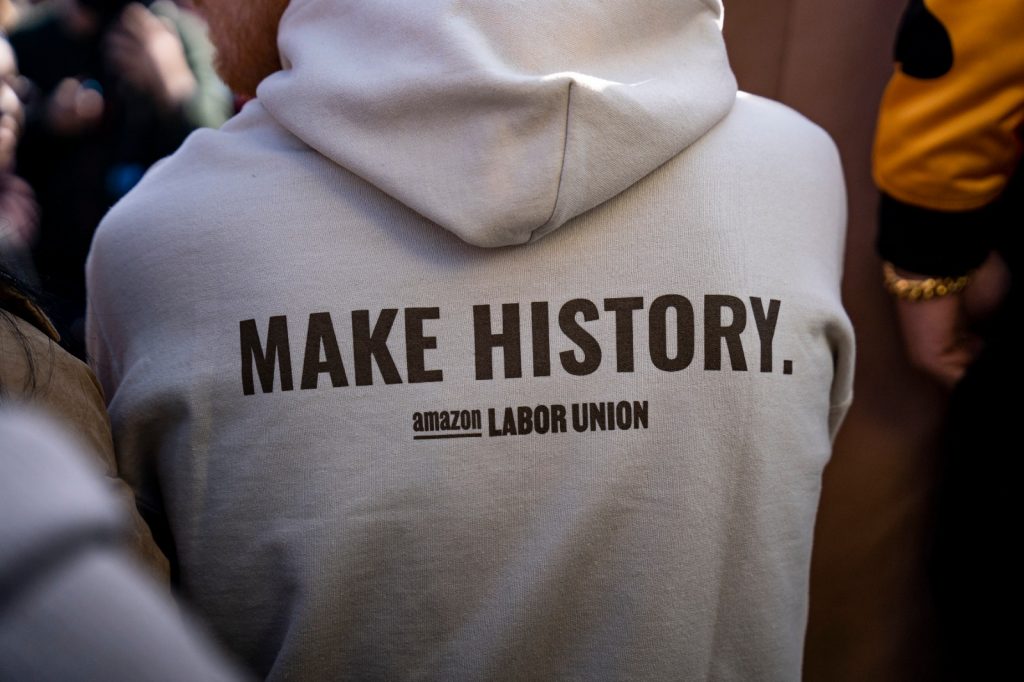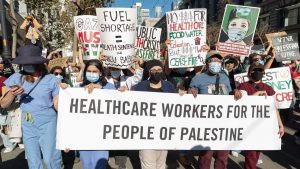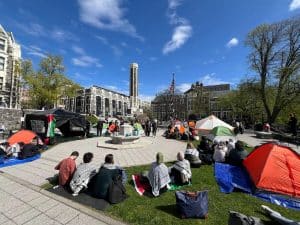Thirty years ago, to paraphrase André Gorz, theorists in the academy said farewell to the proletariat. They argued that changes in the labor process in the last decades of the twentieth century had marked an inexorable weakening of the power of the working class. Still others decreed its inevitable extinction.
While it was difficult even then to argue that the proletariat was extinct when the working class has continued to grow and expand globally, there are still those who argued that workers were set to disappear due to automation. Still others conjured up images of white men in hard hats when they thought of unions and labor, and accused Marxists of reductionism when we spoke of the central importance of the working class.
This May Day refutes all of that.
At this moment, two key truths are evident: the working class is diverse, and the working class is essential. It will not be replaced with machines, but machines will drive the hyper-exploitation and surveillance of workers. And in this context, the United States’ working class is on the move, driven by solidarity for other working-class and oppressed people as well as by hatred for the billionaire bosses.
This May Day marks a sea change.
This year, the working class is in the headlines of every major newspaper, and it seems like new workplaces are filing to unionize every day. According to a report from the National Labor Relations Board (NLRB), from October 1 to March 31, “union representation petitions filed at the NLRB have increased 57%—up to 1,174 from 748 during the first half of FY2021.” The U.S. has been shaken by the historic victory of the first Amazon union, defeating the country’s second largest company and one of the wealthiest men in the world: Jeff Bezos.
Meanwhile, Starbucks workers across the country are also unionizing: at the time of writing, 42 stores have unionized, and roughly 250 locations are awaiting elections.
These changes in the working class have deep roots — the 2008 recession opened a crisis for neoliberalism that hasn’t been resolved. Occupy Wall Street brought an elementary notion of class inequalities — ”We are the 99%” — back into people’s consciousness. The first Black Lives Matter uprising in 2014 taught millions that representation is not liberation. Bernie Sanders capitalized on this discontent during his 2016 presidential bid and strengthened the idea that the working class deserves more, while at the same time steering the discontent into the graveyard of movements, the Democratic Party.
The years of the Trump presidency were characterized by massive protests and the re-emergence of the working class, counter-intuitively in conservative states with the “Red State Revolt,” a wave of teachers’ strikes.
But perhaps nothing has shaped the working class more deeply than the pandemic.
For more than two years, with Covid-19 cases and deaths soaring across the country, workers put their lives on the line while their bosses and corporations increased their wealth exponentially and hid away in their vacation homes. Essential workers kept society running, from healthcare, to transportation, to education, to food. They were called “heroes” — and they were.
And during the pandemic, the working class has learned in the most visceral and brutal ways that their bosses would kill them to turn a profit. Coming from their bosses, the “hero” rhetoric was offensively cynical, as workers were given little more than pizza parties as a thank you. Workers are still overworked and underpaid.
But we have been fighting back.
Last fall, the working class burst onto the scene again during “Striketober.” From Kellogg to John Deere, and from mining to higher education and healthcare, workers used the most powerful tool in their arsenal: the strike.
At the same time, the “Great Resignation” made the capitalists nervous. Millions of workers were quitting, refusing to accept poor working conditions, low wages, stressful environments, and abusive behavior from the bosses.
The experiences of the working class in the pandemic created an intense wave of class hatred, but it also raised our morale, pride, self-respect, and expectations. Workers became aware of our essential role in society. Now, millions of people have begun to identify not as the illusive “middle class,” but as proud working class people.
In the last few months, we have seen the rise of workplaces unionizing. The Amazon Labor Union and the wave of Starbucks unions have put the need for unions on the map. The young people at the forefront of this process have been dubbed “Generation U,” for union. Approval for unions is at a 50 year high, especially among young people.
These new unions still have many struggles ahead. They’re trying to win their first contracts as the CEOs of Amazon and Starbucks fight to bury them and set an example so that the rest of the working class never follow in their footsteps. At the same time, the contract fight is occurring amid massive inflation and Joe Biden’s federal priority of increasing military spending.
The bosses won’t just hand over good contracts — they want to make as much profit off of workers as they can. Our unions must be prepared to fight using the method that has won every major reform for the working class in the past 100 years: our ability to strike. Shutting down Amazon for a day, or even a few hours, would cost the company millions of dollars — after all, its daily revenues exceed $638 million. The bosses don’t do any work — the workers produce these vast profits. The ability to strike is the ability to bring the bosses and the capitalist system to its knees.
And the labor movement has many more struggles to take up.
We must fight to unionize every workplace, including undocumented, part-time, and subcontracted workers. At Amazon, that includes the hyper-exploited drivers who even urinate in water bottles to meet the company’s delivery times.
We must fight for a $30 an hour minimum wage for all, the wage the Amazon Labor Union (ALU) is demanding for Amazon workers on Staten Island. Fifteen dollars is not a living wage, even in the cheapest cities in the United States. Employers and Wall Street are predictably — but falsely — warning that wage increases are driving inflation and will push for wage caps. Earning a living wage that raises the expectations of the entire working class is something the capitalists will try to prevent at all costs, and we must prepare for this battle.
We must also fight every anti-union and every anti-strike law currently on the books. That includes the Taylor Law, which makes it illegal for public sector workers to go on strike in New York City. It also includes the two-part union vote at workplaces that forces unions to go through two elections.
We have to overthrow the anti-union practices that are de facto legalized with the complicity of the NLRB, which allows the use of union busting companies and captive audience meetings to bully workers. We must fight back against retaliation against workers who are unionizing — for example, since February, at least 18 workers have been fired from Starbucks for organizing.
Union leaderships have not been up to the task of defending the basic right to unionization; they haven’t organized the unorganized, instead putting their vast money and resources in the service of Democratic Party politicians. And they have allowed decades of attacks on labor rights to pass, which is why even unionized workers like healthcare workers and teachers are experiencing underpay and burnout and are playing a central part in “The Great Resignation.” The union leaderships’ strategy of subordinating workers’ organizations to the Democratic Party is bankrupt. Neither under the Obama administration nor the Biden administration, when the Democrats have had majorities in Congress, have the Democrats passed laws making it easier to unionize, such as the PRO Act.
For unions to be instruments of struggle, they must be democratized and break with the Democratic Party. They need to develop a grassroots, rank-and-file unionism that we already saw behind the triumph of the ALU; unions should be led by workers.
And, we must fight for Amazon to return the billions in subsidies that state governments have given it to build warehouses. The government has no business giving a single cent to a trillion-dollar company that hyper-exploits workers.
But individual unions cannot take up all these tasks alone. The ALU showed the way forward in a rally last Sunday, April 24, outside the Staten Island warehouses that brought together the union leaders of the American Federation of Teachers, the Teamsters, the Post Office, the New York City subway, and others. These unions, alongside community organizations and leftist and socialist organizations, should work together to organize a plan for struggle, mobilization, and action for a labor summer that fights for what we deserve, and gives the bosses hell.
These unions must take up the demands of oppressed people, such as the fight against racism and homo- and transphobia. Across the country, several unions have taken up the specific demands of their most oppressed workers, like Amazon workers in Minnesota, who held a walkout to demand that Muslim workers be allowed time off to celebrate Ramadan. In March, digital media workers at outlets like Jezebel made trans-inclusive healthcare one of their central demands. Just a week ago, workers at Wendy’s in North Carolina held a walkout against sexual harassment by management.
As anti-trans and anti-LGBTQ+ bills are passed across the United States and the right to an abortion is threatened, our unions and the emerging working-class movement must act as a pillar against the advance of the far right and against all of the laws threatening oppressed people.
While we are denied basic rights like access to health care, education, and housing, the government — whether helmed by Democrats or Republicans — doesn’t hesitate to spend billions of dollars on the military. “Generation U” has inspired workers globally and is well aware of racist and xenophobic oppression.
These workers must develop international solidarity with the working class of the Global South, which is oppressed by U.S. imperialism. The corporations that exploit us, strip us of our rights, and enrich themselves at our expense do so on an even larger scale around the world. We must stand up against the U.S. military machine and fight against the massive military budget. It is key that the U.S. working class reject the pro-war propaganda in the media; we have nothing to gain from Biden’s war in Ukraine, although workers also have nothing to gain from Putin or Zelensky.
Internationalism and anti-imperialism are vital. Just as millions of workers around the world were thrilled with the victory against Amazon in the heart of imperialism, so, too, must we be thrilled and surrounded by solidarity in every workers’ struggle.
Let this May Day mark the start of a new combative labor movement in the United States, in the tradition of the Chicago martyrs that May Day commemorates. Let us remember and come back to the best of the Bread and Roses Strike of 1911, Seattle General Strike of 1919, the Minneapolis General Strike of 1934, and of the sit-down strikes of the 1930s.
The entire socialist Left must embrace unity of the ranks of the workers and the triumph of the struggles underway as a central goal. There is great potential for a sector to emerge from within these struggles that, in addition to organizing and fighting in the workplace, knows how to organize a political alternative independent of the parties of the capitalists, the Democratic and Republican Parties, that represent our exploiters.












